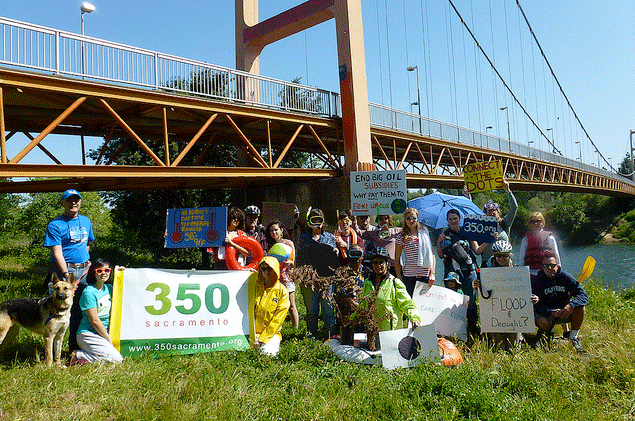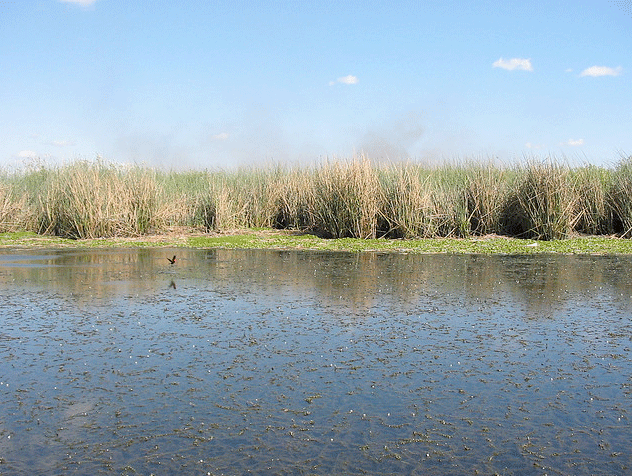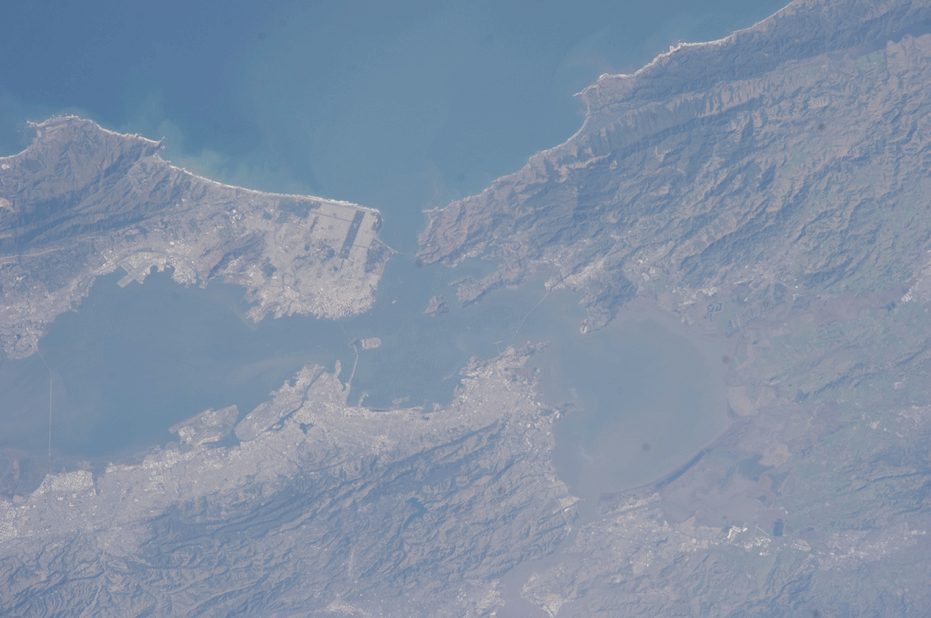Delta Risk
Air Date: Week of November 2, 2012

350.org organizers working to raise awareness about Sacramento’s aging levee system. (350.org)
Evaluating disaster risk is a major industry and researchers in California are working to reinvent how it’s done. Lauren Sommer has the story from IEEE Spectrum Magazine National Science Foundation special "Responding to Disasters, from Prediction to Recovery."
Transcript
CURWOOD: Well, whether it’s a hurricane or oilrig explosion, disasters take a huge toll. So it makes sense that evaluating disaster risk is a major industry. But as much as it might help, risk assessment can also get in the way, especially when it gives a false sense of security. Researchers at the University of California-Berkeley are working to reinvent risk assessment.
From IEEE Spectrum Magazine, National Science Foundation special "Responding to Disasters, from Prediction to Recovery" Lauren Sommer has our story. She travelled to a fragile part of California where risk is a way of life.
[DRIVING NOISE, BUMPS]
SOMMER: I’m driving down a bumpy road on top of a levee near the Sacramento River, about 50 miles east of San Francisco.
STORESUND: So we are at Sherman Island, which is the gateway to the Delta from the San Francisco Bay.

Low tide in the Sacramento-San Joaquin Delta, California. (Photo: T. Pennington)
SOMMER: My guide is Rune Storesund, a researcher at UC Berkeley. He’s part of a team developing a new engineering concept called Resilient and Sustainable Infrastructures, or RESIN.
STORESUND: And I’ll pull over near the – right before the bridge, kind of right next to Three Mile Slough.
[TURN SIGNAL SOUND, TRAFFIC SOUNDS]
SOMMER: This is the Sacramento-San Joaquin Delta. And if you’ve heard anything about water battles in California, chances are they were happening here. The Delta is where two major rivers meet and flow out to San Francisco Bay. At least, they used to. Today, a lot of that water is pumped elsewhere.
STORESUND: A lot of Southern California’s water comes through the Delta through the State Water Project.
SOMMER: We’re driving next to the river on one side and fields of corn on the other. Well, not exactly next to us. The corn on Sherman Island is about twenty feet below the road.
STORESUND: These channels are all tidally influenced, so you could call that sea level. So these are all below sea level, yeah.
SOMMER: Most of the islands in the Delta aren’t natural. Beginning in the late 1800s, people built levees to hold back the rivers and marshes so they could farm. But the peat soil they exposed has decayed over time, which means these islands are sinking.
STORESUND: Something that’s, you know, maybe a tenth of an inch per year over a hundred years is a lot of inches.
SOMMER: And Storesund says the levees aren’t in great condition.
STORESUND: You’ll see that there are cracks and bulges in the road. Those are signs that the levee sides are shifting and moving and slumping.
SOMMER: Water seeps underneath the levees, so these islands have pumps running night and day to keep the land dry. But seepage can also weaken levees. And you don’t have to go far to see the devastating results.

San Francisco Bay (NASA)
STORESUND: So we are now on top of the breach here at Upper Jones Tract in 2004. And then if you look to your right and the cornfields out there, all of that was pretty much wiped out when the breach occurred.
SOMMER: The levee failure flooded 12,000 acres, damaging railroad tracks, a power substation and an aqueduct that runs to the Bay Area. And it wasn’t the first time. Jones Tract also flooded in 1980.
STORESUND: This breach repair actually leaks significantly.
SOMMER: The Delta is home to a lot of major infrastructure - gas lines, transmission lines, railroad, highways – and it all depends on the levees. These levees also feed freshwater to pumps that carry it to Southern California. So, Storesund says a major disaster in the Delta would be felt across the state.
STOREUSND: It’s very significant. You know, we’re talking billions of dollars. I think if a major earthquake occurred that failed a number of levees, it would be months to years before the State Water Project were up and running again.
SOMMER: It’s mind-boggling to add up all these interconnected risks: sinking islands, weak levees, sea level rise, earthquakes… it’s difficult for any government agency to address them all.
STORESUND: And you have a lot of different organizations who have a stake in the Delta and who have an impact and an influence, with really nobody in charge.
SOMMER: But all those factors make it a very good place to study risk -- and to try to change the way it’s done.
STORESUND: A lot of the risk analyses are very difficult, complex, not transparent, and when decision-makers look at them, it doesn’t really tell them a whole lot. And so we’re trying very hard to come up with new ways of communicating not just the results of the risk analysis, but the composition of it is as well.
BEA: It took a long time to get what we call this entangled mess. That’s how I describe the California Delta.
SOMMER: Robert Bea heads up the RESIN project at UC Berkeley.
BEA: The likelihoods of failure and consequences of failure can bring to its knees, I think it’s now the eighth largest economy in the world, that economy for a period in excess of five years.
SOMMER: Bea has spent his career studying disasters. In fact, his students have a nickname for him.
BEA: Dr. Disaster. I joke with people--in many ways, my career has been one disaster after another.
SOMMER: Bea has studied oilrig explosions, hurricanes, refinery fires… But there’s one disaster that has shaped his career and his life.
BEA: Hurricane Betsy is 1965, September the 9th. We'd just bought our new home. Just had our first son.
SOMMER: Bea and his wife were living in New Orleans when the hurricane hit.
BEA: At midnight, we evacuated our home in 100 mile per hour winds. The next day, I go back into the home, and I swam back, because the water was to our roof. We lost everything.
SOMMER: A nearby levee had failed. Bea and his wife sold the property and started over. In 2005, when Hurricane Katrina hit, Bea went back to New Orleans and visited his former neighborhood.
BEA: And in fact, the levy that failed in 1965 failed again in 2005, in the same place. So I go back, drove up to the home and the neighbors were dragging wet, oily mattresses out of the front door, just as I had done 40 years earlier. I broke down and cried. And it wasn't so much I was sad. I was just madder than hell.
SOMMER: The more Bea studied disasters, the more he realized what was missing from his risk assessment.
BEA: I’ve been working 10 percent of the problem. I’ve been working these traditional engineering things that I love so much, and ignoring the 90% called people.
SOMMER: Bea says people, or human and organizational factors as he calls them, have had a major role in all of the disasters he’s studied. But it’s not easy for engineers to take them in account.
BEA: I joke and say engineers hate uncertainties because our world is most comfortable when it's deterministic.
SOMMER: Bea and this team are trying to define these uncertainties in the Delta. Normally, risk analysis is expressed in one number – that there’s a 75% chance of failure, for example. Instead, the RESIN team is defining a best-case scenario, worst-case scenario and what is likely to happen. Bea says that provides decision makers with more information to work with. And they’re doing their analysis over a longer period.
BEA: You put yourself out in 2100, and you look back, and say, I can't use a patch and pray approach, because if I do, I’m going to fail. It's going to be horribly expensive, so you start to develop what I call the 'let's get the hell out of Dodge City,' approach, which means a strategic withdrawal over a long period of time involving an infrastructure system that we can turn over to future generations that is sustainable.
SOMMER: Bea says the big challenge in the Delta is the number of decision makers, each with their own risk analysis. Bea and his team are working with them to develop a more integrated risk assessment that includes human uncertainties.
BEA: The acceptance has been varied. It is still amazing to me to watch the push back from engineering itself. Change is hell.
SOMMER: For his part, Bea is injecting social science into the engineering curriculum at UC Berkeley. He says while it may not be easy to fit human behavior into mathematical equations, it’s crucial to more accurately portray risk -- and to prevent future disasters.
BEA: If we make big mistakes, that's not a good thing, but if we can reflect deeply on how we made them, then we have a chance in not doing it again.
SOMMER: In Berkeley, California, I’m Lauren Sommer.
[MUSIC: Donald Fagan “Weather In My Head” from Sunken Condos (Reprise Records 2012).]
CURWOOD: Lauren's story comes to us from IEEE Spectrum Magazine, National Science Foundation special "Responding to Disasters, from Prediction to Recovery”.
Living on Earth wants to hear from you!
Living on Earth
62 Calef Highway, Suite 212
Lee, NH 03861
Telephone: 617-287-4121
E-mail: comments@loe.org
Newsletter [Click here]
Donate to Living on Earth!
Living on Earth is an independent media program and relies entirely on contributions from listeners and institutions supporting public service. Please donate now to preserve an independent environmental voice.
NewsletterLiving on Earth offers a weekly delivery of the show's rundown to your mailbox. Sign up for our newsletter today!
 Sailors For The Sea: Be the change you want to sea.
Sailors For The Sea: Be the change you want to sea.
 The Grantham Foundation for the Protection of the Environment: Committed to protecting and improving the health of the global environment.
The Grantham Foundation for the Protection of the Environment: Committed to protecting and improving the health of the global environment.
 Contribute to Living on Earth and receive, as our gift to you, an archival print of one of Mark Seth Lender's extraordinary wildlife photographs. Follow the link to see Mark's current collection of photographs.
Contribute to Living on Earth and receive, as our gift to you, an archival print of one of Mark Seth Lender's extraordinary wildlife photographs. Follow the link to see Mark's current collection of photographs.
 Buy a signed copy of Mark Seth Lender's book Smeagull the Seagull & support Living on Earth
Buy a signed copy of Mark Seth Lender's book Smeagull the Seagull & support Living on Earth

